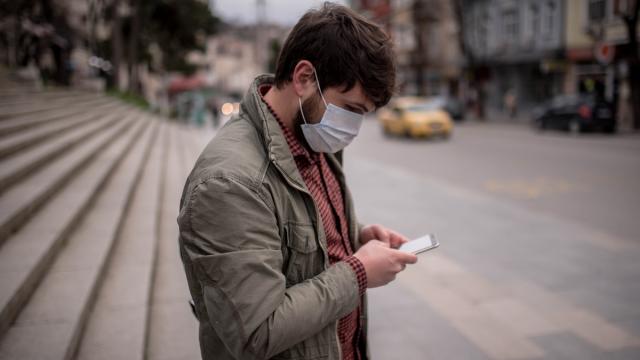As that anti-masker having a tantrum in a Panera pointed out, you can smell a fart even though it passes through the fabric of your pants. Her point seems to be that fabric cannot block air, and thus masks cannot block things that are carried in air. She’s wrong, but let’s examine why.
A cloth mask’s job is to block droplets containing the coronavirus. It works best to block the large droplets that come from your own mouth and nose (so you won’t risk infecting others), but it may also provide some protection against droplets produced by other people.
How big are the holes in a mask?
The holes in a mask are not necessarily all the same size, and there are other factors that affect what sizes of particles can get through. (For example, multiple layers of fabric will protect better than one.) So the more important question to ask, rather than how big the holes in a mask are, is how well the mask filters particles of various sizes.
A recent paper on cloth masks tested this and found that various fabrics blocked anywhere between 5% and 80% of particles smaller than 300 nanometres. For larger particles — bigger than 300 nanometres — some fabrics worked better than others, blocking a range of between 5% to 95% of particles.
Once you combine a few layers of fabric, though, the filtration efficiencies go way up. They found several combinations that filtered over 80% of the smaller particles and over 90% of the larger ones.
How big is a fart?
The smell of a fart is caused by its sulphur-containing molecules. Chemistry professor Trevor Makal points out on Twitter that a typical one, methanthiol, is about 0.4 nanometres. That’s very, very small — the proverbial mosquito through the chain link fence.
As a result, you can smell a fart after it passes through pants and underwear. You can also smell it through a mask.
How big is a virus?
Viruses come in different sizes, but the coronavirus that causes COVID-19 has been measured at 60 to 140 nanometres, or between 14,900% and 34,900% larger than a small, stinky molecule like methanthiol.
What about respiratory droplets?
Aha! You’ve been paying attention. The virus doesn’t necessarily travel on its own; it’s expelled from our mouths and noses as part of droplets. Droplets are much larger than the other things we’ve been talking about, and are often measured in micrometres, but I’ll convert to nanometres here to keep things consistent.
The droplets from sneezes are about 100,000 nanometres. The droplets from coughs are smaller, around 1,000 nanometres. (I’m getting my number from this review paper, SARS-CoV-2 (COVID-19) by the Numbers, which will answer many of your numerical questions about the coronavirus.)
What about aerosols? The definitions of “aerosol” and “airborne” are somewhat controversial, so we’ll just say that we’re worried about small droplets, which are considered to be those under 5,000 nanometres. A good mask should stop most of those.
What else passes through a mask?
Air. Oxygen and carbon dioxide are both less than 1 nanometre wide. They are not trapped in droplets and can move freely through the mask as you breathe. A quick way to verify this: The size of an average breath is about 500 milliliters, or about the same volume as a water bottle. The space between your mask and your face is far smaller than the volume of a water bottle. Therefore, the air you exhale clearly exits the mask with each breath.
Some of the air goes through the pores of the mask, but if your mask fits loosely, some of it may go through gaps at the sides of your cheeks, the sides of your nose or under your chin. That’s why it’s important to wear your mask correctly to ensure that as much air as possible gets filtered by the mask material.
One last thing: if you’re getting ready to argue this with somebody who tells you that masks don’t work, be aware that they may argue that masks can’t block viruses at the same time they argue that masks are harmful because they block air. Both of these can’t be true at the same time, so you may want to ask them to clarify their position (does it filter too well, or not well enough?) before you proceed.

Leave a Reply
You must be logged in to post a comment.